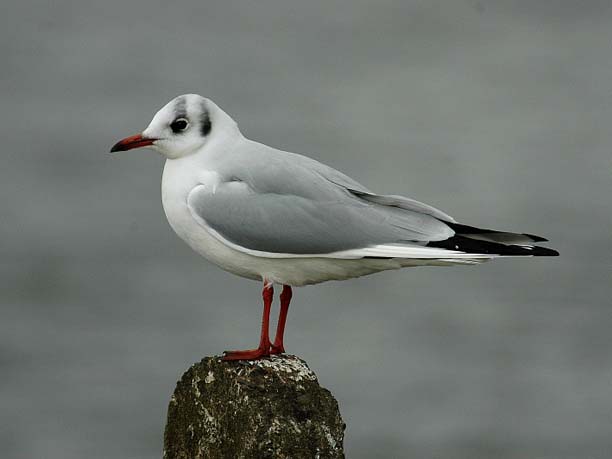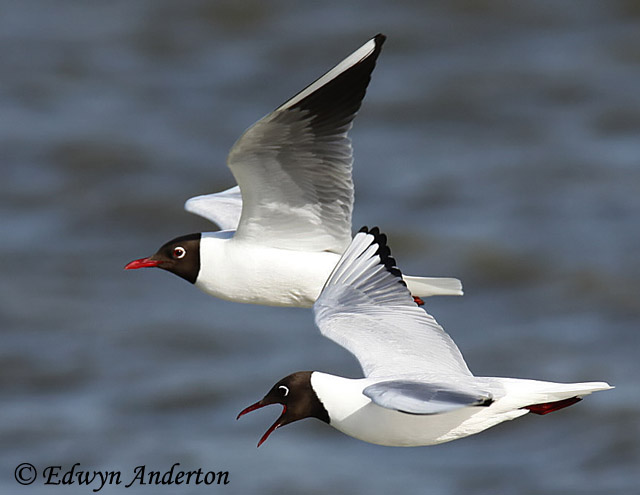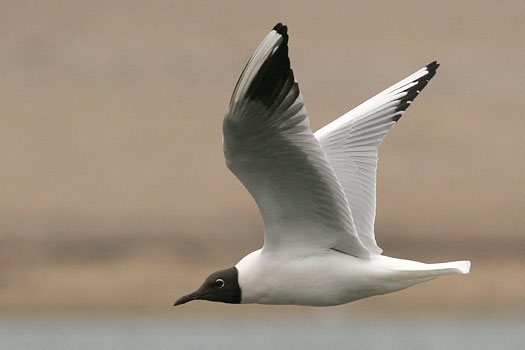
Larus ridibundus
SUBFAMILY
Larinae
TAXONOMY
Larus ridibundus Linnaeus, 1776, England. Monotypic.
OTHER COMMON NAMES
English: Black-headed gull; French: Mouette rieuse; German:
Lachmцwe; Spanish: Gaviota Reidora.
PHYSICAL CHARACTERISTICS
14.5–17 in (37–43 cm); 0.4–0.7 lb (185–325 g). Small gull with
a dark chocolate brown frontal hood, white eye crescents larger
toward back of eye, and blood-red bill during breeding season.
Gray mantle, black wings, and white neck, throat, and belly.
Newly arriving birds at breeding colonies have pinkish bloom
to breast that fades quickly. Nonbreeding adult has white head
with dusky spot on ear coverts. Juvenile has rich buff to darker
brown markings on upperparts and upperwing coverts.
DISTRIBUTION
Southern Greenland and Iceland through most of Europe to
Central Asia and extreme southeast Russia and northeast
China. Marginal, but possibly increasing in North America.
Winters in West and East Africa, Malaysia, and Philippines.
HABITAT
Nests mainly in marshes and on sand dunes among grasses of
Palearctic; always near water, chiefly inland and along coasts.
Winters in marshes, rivers, and along coasts, but not pelagically
(in the open sea).
BEHAVIOR
Diurnal, territorial, forages and nests in groups of conspecifics
or with terns.
FEEDING ECOLOGY AND DIET
Relies mainly on aquatic and terrestrial insects, earthworms,
and marine invertebrates, as well as fish. Also eats fruits and
grains. Feeds by a variety of methods, including walking, swimming,
seizing objects from water or land, foot paddling, or by
plunge-diving for fish, often behind fishing boats.
REPRODUCTIVE BIOLOGY
Monogamous, high colony-site and nest-site fidelity, returns to
site in late February to May. Most nest in small colonies of less
than 100 pairs, some as large as 10,000 pairs. Usual clutch size
of two to three eggs. Incubation period 22–26 days. Fledging
period 32–35 days. Limited post-fledging care. Breeds when
two to three years old.
CONSERVATION STATUS
Not threatened, although often displaced from traditional
breeding colonies on sand habitats by herring gulls. Eggs still
collected for food; some meat eaten.
SIGNIFICANCE TO HUMANS
Used extensively as a source of eggs in the past, when sections
of colonies were “owned” by individuals who carefully managed
them for sustained yield. Some colonies in England and
elsewhere maintained for several centuries.
Other popular Animals
Photo Gallery of - Common black-headed gull




 Animalia Life
Animalia Life